By Matthew Kirsch
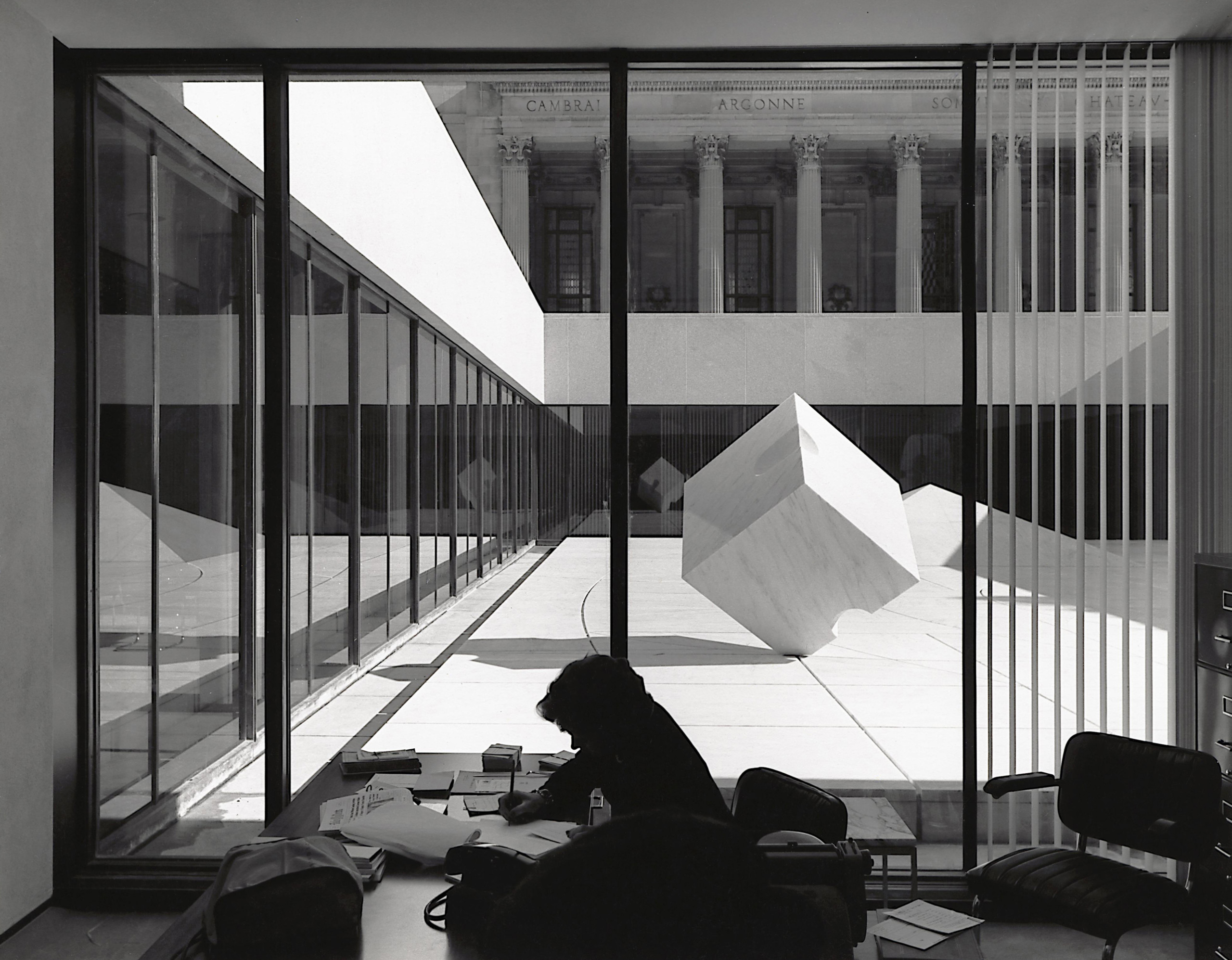
In interviews and his own writings, Isamu Noguchi vacillated wildly between supreme optimism about the potential symbiosis between sculpture and architecture and abject bitterness about his experiences working with actual architects. He was frustrated by the natural power imbalance he saw in the commissions that came through architects, for buildings and spaces that were often nearly fully planned (and with their budgets spoken for) before he entered the picture. In Noguchi’s view, the prospect of a sculptural commission “smacks of the academic past, and turns out as decoration.”1 He felt that a lone sculpture, merely scaled to fit the proportion of a building or courtyard, did little to relate passersby to their surroundings or even to engage them with an architect’s careful planning.

- Gardens at Reader’s Digest Building, Tokyo (1951). ©INFGM / ARS
As well founded as his skepticism about such commissions may have been, based on his share of failed proposals, Noguchi considered nearly every offer and remained steadfastly open to collaboration with architects. When he was offered a chance to create a garden surrounding Antonin Raymond’s Reader’s Digest Building in Tokyo in 1951, he eagerly accepted, making do with the leftover earth and stone excavated during the building’s construction, to which he added water channels and a cast iron fountain (above). He was paid only a nominal fee for the job, which, as he later explained, was often the case, but worth it in order to have the opportunity to shape space on a large scale. The completion of the garden for Reader’s Digest gave Noguchi some material evidence to continue his lobbying for a reconsideration of his role during a period when he met new and sympathetic collaborators and renewed contact with others from his journeyman days. His emerging confidence is evident in a letter to his friend, the architect Edward Durell Stone, a few years later:


[T]he place of sculpture in relation to architecture should be as part of a general consideration of space, use, mood, environment, as accents and as meaning. That is why I am doing gardens, and why I have done so much in the dance theater.
The total concept which to me is an essential extension of sculpture (which most sculptors don’t even think about) may not be recognized as sculpture; neither may the elements that compose it … I say what of it? Maybe the anonymity that comes from perfect integration is not such a bad thing—where the totality amounts to a moving experience, so a single part is as important as the whole.
It is true that the experience of sculpture is generally held to be inherent in the piece itself. Now we are aware of a new space relationship which is extensive. This again we limit and call sculpture, but extended it becomes significant environment. This is where I believe sculpture truly enters architecture.2
With the benefit of another decade of cumulative collaborative experience working with some of the most well-regarded architects in the United States and Japan, Noguchi articulated this thinking further in his 1968 autobiography and in writings like “The Sculptor and the Architect” from 1968. He remained skeptical about architecture’s seeming condescension to sculpture. But, struggling through the construction of the Billy Rose Sculpture Garden at the Israel Museum in Jerusalem (1960–65), a gallery without ceilings, where he became co-architect in all but name,3 and working with Louis Kahn on a park in New York, he also developed at least a degree of appreciation for the architect’s role.


Emigré film director Josef von Sternberg commissioned fellow Austrian American, Richard Neutra, to design a house for him in California’s San Fernando Valley in 1935. Von Sternberg was a prescient collector of European avant-garde painters and his selection of Neutra reflected similar forward thinking. Neutra, who established his firm in Los Angeles in 1925 and later featured in the Museum of Modern Art’s first survey of International style architecture in 1932, drafted Noguchi (then looking for work in Los Angeles during a fallow period in New York) to develop a swimming pool for an early iteration of his plan.4 Coming not long after his work on a multifaceted play environment (Play Mountain, 1933), a swimming pool was an ideal design brief for Noguchi, allowing him to adapt certain ideas from a public scheme to a private commission. His pool design gave consideration almost solely to the singular scale and body of von Sternberg (who was described as quite portly by that time). Noguchi planned a ramp and multilevel perches as part of “a beautiful curving, flowing form from an orderly sequence of various activities.”5 Although Noguchi’s sinuous design offset the stacked geometry of Neutra’s, the architect decided against using the pool in his final design, likely because of a reflecting pool that bordered the large courtyard he had planned. The von Sternberg house passed through various owners before being demolished in 1971, despite Neutra’s reputation as one of the West Coast’s preeminent modern architects.




Arkansas-born modernist Edward Durell Stone helped to shape both mid-century residential architecture and midtown Manhattan. He was involved with both the theater at Radio City Music Hall at Rockefeller Center (1932) and the Museum of Modern Art’s original 53rd Street building, the first International style building in New York, designed with Philip L. Goodwin (1939). After visiting the house that Stone built for MoMA president at the time, A. Conger Goodyear, in Old Westbury, Long Island in 1938, Noguchi was asked by Goodyear to design a unique table for it. In essence, it was less a collaboration with Stone than a response to a place and a specific setting, a central position in the Goodyear living room, in front of floor-to-ceiling windows overlooking the garden. This horizon influenced Noguchi’s design of a kidney-shaped glass sheet balanced on a dynamically fanned base of stacked, laminated rosewood.6
The first true collaboration between Stone and Noguchi was a competition submission for Jefferson National Expansion Memorial Park7 on the waterfront of St. Louis (1947). The competition materials laid out only a few requirements, including a museum building and a central monument alluding to general themes of westward expansion. The few existing photographs of Noguchi’s project model find that he and Stone deemphasized any central monument while the competition drawings indicate that most of its architectural elements were buried below ground in favor of “growing things, water and sculpturally molded terrain.”8 Noguchi’s contribution is most evident in a play area inspired by American Indian mounds (specifically, a visit to the Great Serpent Mound in Marietta, Ohio) and his own earth-formed concept, Contoured Playground (1941). That they would respond to a call for plastic expressions of Manifest Destiny—as the Saarinen firm’s winning 630-foot-tall Gateway Arch does so brilliantly—with a subtle invocation of America’s indigenous past, is telling.

- Isamu Noguchi, Sculpture For Brussels World’s Fair, 1957. ©INFGM / ARS
In the late 1950s, Stone sought out Noguchi for sculptural commissions for his United States Embassy building in New Delhi (1954–59) and for the United States Pavilion at the Brussels World’s Fair (1958). Noguchi offered a design for a sculptural ensemble for New Delhi while pressing to be allowed to create a broader garden space more in dialogue with Stone’s building. Stone failed to convince the U.S. Office of Foreign Buildings to accept Noguchi’s plan, and in the end, no sculpture was commissioned. However, the sculpture for the U.S. Pavilion at the Brussels World’s Fair did materialize—13 feet tall, in stainless steel—but it seems to have receded into the background of an Expo-wide exhibition, 50 ans d’art moderne (Fifty Years of Modern Art), as no photograph exists of it installed there.
In a well-publicized May 1950 lecture, and in media coverage of his first visit to Japan in nineteen years, Noguchi publicly expressed his hope for the development of a forward-thinking Japanese avant-garde reacquainted with its own organic cultural heritage. He met Kenzo Tange, a sympathetic outlier in the fields of architecture and urban planning, soon after. Tange was drawn to Le Corbusier’s buildings as a student in the 1930s, but he acquired an appreciation for Japan’s architectural heritage as a graduate student at Tokyo University and then as a member of its faculty, and passed on its lessons to his associates at Tange Laboratory (established 1946). Tange later wrote a major text (and art directed Ishimoto Yasuhiro’s photographs) for a 1960 publication on Katsura Imperial Villa in Kyoto, a site he and Noguchi visited together during Noguchi’s periodic residence in Japan in the 1950s.

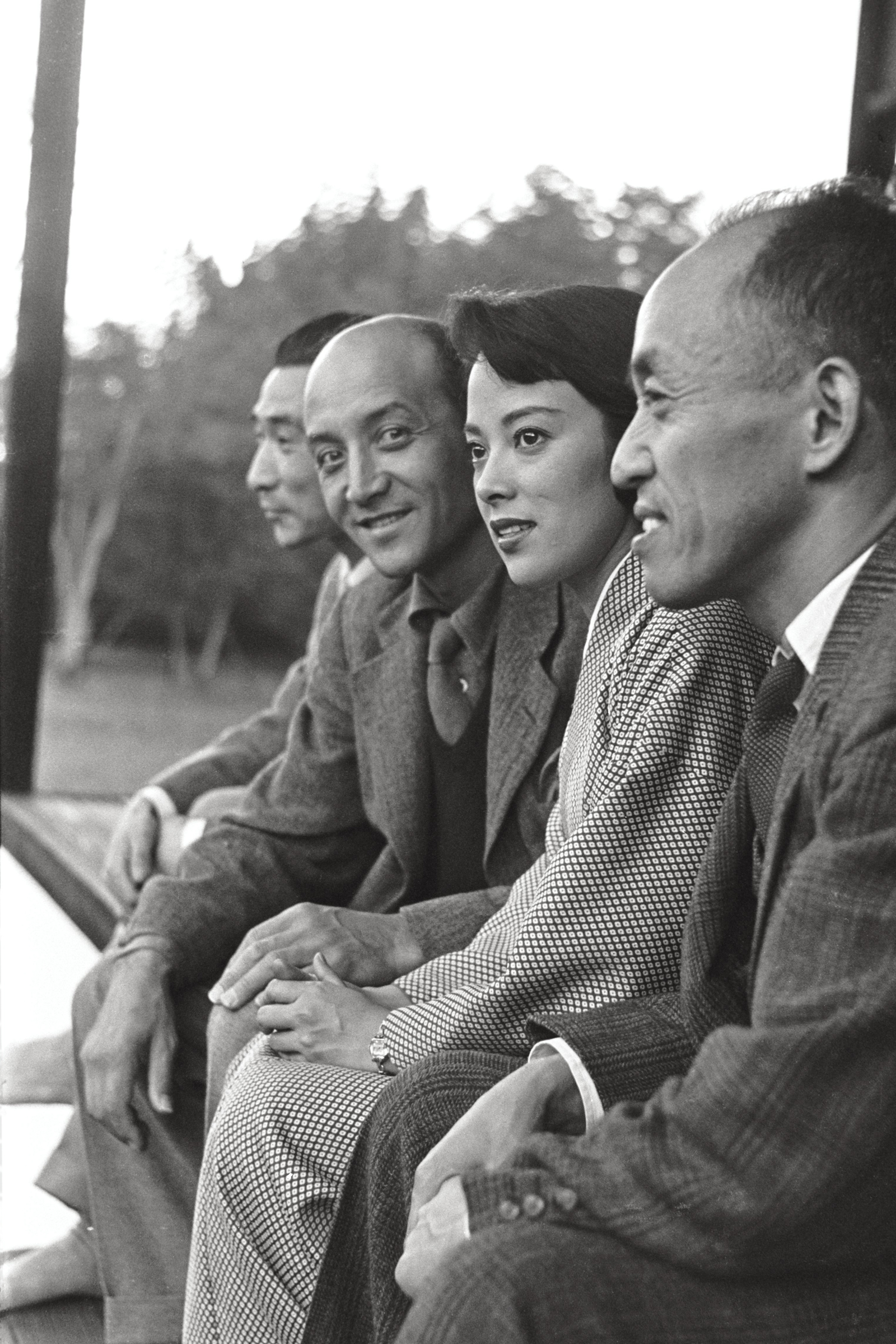





- Isamu Noguchi, Kenzo Tange, and Michio Noguchi in Hiroshima, Japan, 1951. ©INFGM / ARS
- (From left) Kenzo Tange, Isamu Noguchi, Yoshiko Yamaguchi, and unidentified priest at Katsura Imperial Villa, Japan, 1950s. The Noguchi Museum Archives. ©INFGM / ARS
- Isamu Noguchi, Model for Memorial for the Dead of Hiroshima, 1952. Photo: Isamu Noguchi. ©INFGM / ARS
- Isamu Noguchi, Model for Memorial for the Dead of Hiroshima, 1952. Photo: Isamu Noguchi. ©INFGM / ARS
- Isamu Noguchi, Model for Memorial for the Dead of Hiroshima, 1952. Photo: Isamu Noguchi. ©INFGM / ARS
- Isamu Noguchi, Hiroshima Bridge Railings, 1950s. Photo: Isamu Noguchi. ©INFGM / ARS
- Isamu Noguchi, Hiroshima Bridge Railings, 1950s. Photo: Isamu Noguchi. ©INFGM / ARS
Beginning in 1947, Tange advised a civic committee in Hiroshima overseeing a major urban planning project to rebuild the war-ravaged city. He solicited Noguchi for two related projects: a pair of cast concrete railings for a prominent bridge leading to the Peace Park, the centerpiece of his plan; and a Memorial to the Dead, Hiroshima, a funerary cenotaph to Hiroshima’s atomic war dead on a plaza that would extend below to an underground space for reflection. Noguchi’s cast concrete bridge railings were realized in 1952, but the committee rejected his memorial. Noguchi’s disappointment over the latter was soured further by Tange’s own redesign, which Noguchi perceived as an appropriation of his plan.
Their friendship survived, however. For Tange and Uso Nishiyama’s Expo ’70 campus in Osaka, Japan, Noguchi conceived a program of nine automated fountains for three ponds near Tange’s central Festival Plaza (1970).
Arguably their most successful collaboration was designed for Noguchi and Tange’s mutual friends, master flower arranger Sofu Teshigahara and his artist-filmmaker son Hiroshi, who transformed their traditional school for ikebana into an arts and performance space, Sogetsu Center, in Tokyo. Noguchi created a terraced landscape that doubled as a versatile display space, Tengoku (Heaven), in a vertically spacious lobby that concealed an auditorium below (1977–78).9
After years of citing the Italian piazza as his ideal in its balance of sculptural presence and communal space, Noguchi got the opportunity to design his own hybrid version at a site within Tange’s redevelopment of a business and exhibition district in Bologna, Italy, Fiere di Bologna (1979). Noguchi placed a Japanese-inspired horizontal granite gate and shallow arena-like octagonal recess to resolve the scale of Tange’s surrounding towers.






- Isamu Noguchi, Expo '70 Fountains, Osaka, Japan, 1970. Photo: Michio Noguchi. ©INFGM / ARS
- Isamu Noguchi, Expo '70 Fountains, Osaka, Japan, 1970. Photo: Michio Noguchi. ©INFGM / ARS
- Isamu Noguchi, Heaven (Tengoku), Sogetsu Ikebana, Tokyo, 1977–78. Photo: Michio Noguchi. ©INFGM / ARS
- Isamu Noguchi, Heaven (Tengoku), Sogetsu Ikebana, Tokyo, 1977–78. Photo: Michio Noguchi. ©INFGM / ARS
- Isamu Noguchi, Piazza di Fiere, Bologna, c. 1979. ©INFGM / ARS
- Isamu Noguchi, Piazza di Fiere, Bologna, c. 1979. ©INFGM / ARS
A Bauhaus-trained designer who graduated to become one of the school’s architecture instructors, Marcel Breuer followed his mentor Walter Gropius to Harvard in the 1930s before logging a number of residential commissions with his own New York firm in the 1940s. In 1952, UNESCO’s architectural committee appointed Breuer, Pier Luigi Nervi, and Bernard Zehrfuss as co-architects of its headquarters in Paris. With the partners’ design for the campus already underway, a separate committee made a selection of international artists to participate. Breuer suggested Noguchi as a candidate for the Delegates’ Patio, a seating area on a triangular plot outside the building where the Secretariat met—the “three-pointed star.” It was with Breuer’s support in 1956 that Noguchi was able to tease out possibilities from this original commission for the patio. A letter from Breuer to Noguchi illustrates some of the loose initial ideas Noguchi proposed: adjusting the placement of walls near the patio (Breuer admonished him not to play with the building plan); planting trees on the porch (impossible because of a basement below); and adding terraces, landscaping, and a water basin to the mostly vacant area between the buildings, where Alexander Calder’s sculpture was to be sited.10
Initially, Noguchi was concerned with finding a way to resolve the difference in elevation between the porch and the area below it. Noguchi’s plan evolved into an immersive “somewhat Japanese garden”11 that harmonized the space between buildings through plantings, water courses, stone arrangements, and a long ramp leading to the patio. It was Breuer’s suggestion to involve the Japanese government as a sponsor for this new scope, which Noguchi insisted should include raw stones sourced and transported from Japan.




More than twenty years later, a commission from the Cleveland Museum of Art resulted in Noguchi coming up with an arrangement of three Japanese basalts, Rock Carvings: Passage of the Seasons (1980–81), placed outside the entrance of Breuer’s north building, a 1970 addition.








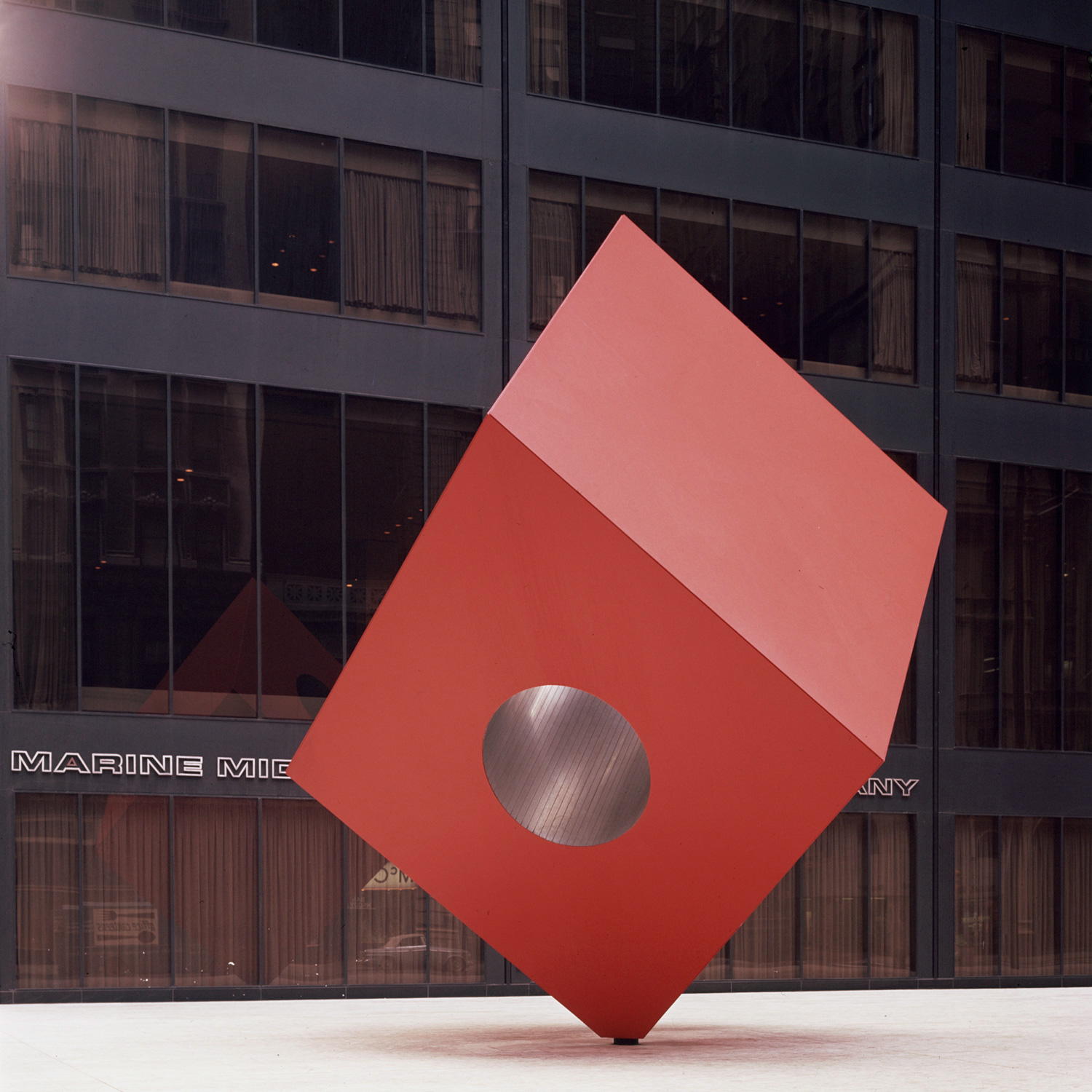

“Very few artists know much about architecture; the only exception would be Noguchi. He knows it all and probably thinks he could be an architect.”12 Gordon Bunshaft’s brusque estimation of Noguchi gives a sense of the push and pull that defined his collaboration with the prickly artist—on some of Noguchi’s most creatively rewarding commissions—in the 1950s and 1960s. Initially, Bunshaft and his firm, Skidmore, Owings & Merrill (SOM), solicited and ultimately passed on two separate courtyard designs by Noguchi for the firm’s Lever Brothers Building in 1952. Bunshaft successfully involved Noguchi on two quietly influential corporate headquarters—the gardens at the Wilde Building, the headquarters of the Connecticut General Life Insurance Company in Bloomfield, Connecticut (1956–57), and the IBM headquarters in Armonk, New York (1964)—for which Noguchi developed programs of plantings, reflecting pools, and stone accents across separate courtyards, giving a sense of continuity and interplay between spaces. Their success at Connecticut General aided Bunshaft when he successfully lobbied on Noguchi’s behalf in 1960 after the artist proposed quarrying granite from remote Mount Tsukuba in northern Japan for a job at First National Bank Plaza in Fort Worth, Texas (1960–61).
Three projects largely personify Noguchi’s collaboration with the most public face at SOM: sunken gardens at both the Beinecke Rare Book Room and Library at Yale University, New Haven (1960–64) and Chase Manhattan Plaza, New York (1961–64); and Noguchi’s Red Cube, for the plaza at 140 Broadway in Manhattan (1968). In each case, Bunshaft inspired some of Noguchi’s most allusive solutions: an abstract field of white Danby marble that is “nowhere, yet somehow familiar … infinite space or cloistered confinement”13 for Yale; a water garden in lower Manhattan with seven river-eroded stones that references both the garden at Ryoanji Temple and the Cold War-era space race for Chase; and a delicately balanced twenty-eight-foot-tall rhombohedron whose mass counters Bunshaft’s fifty-one-story Marine Midland Building. The latter commission was a forced compromise on Noguchi’s part; Bunshaft dismissed a concept Noguchi had envisioned in stone and directed him to work with one of his more geometric proposals. In most instances Noguchi came up with various treatments to submit to Bunshaft’s highly critical eye, and their solutions were always refined through consensus. With genuine, but grudging, respect Noguchi later recalled, “Bunshaft always urged me to do more not less.”14

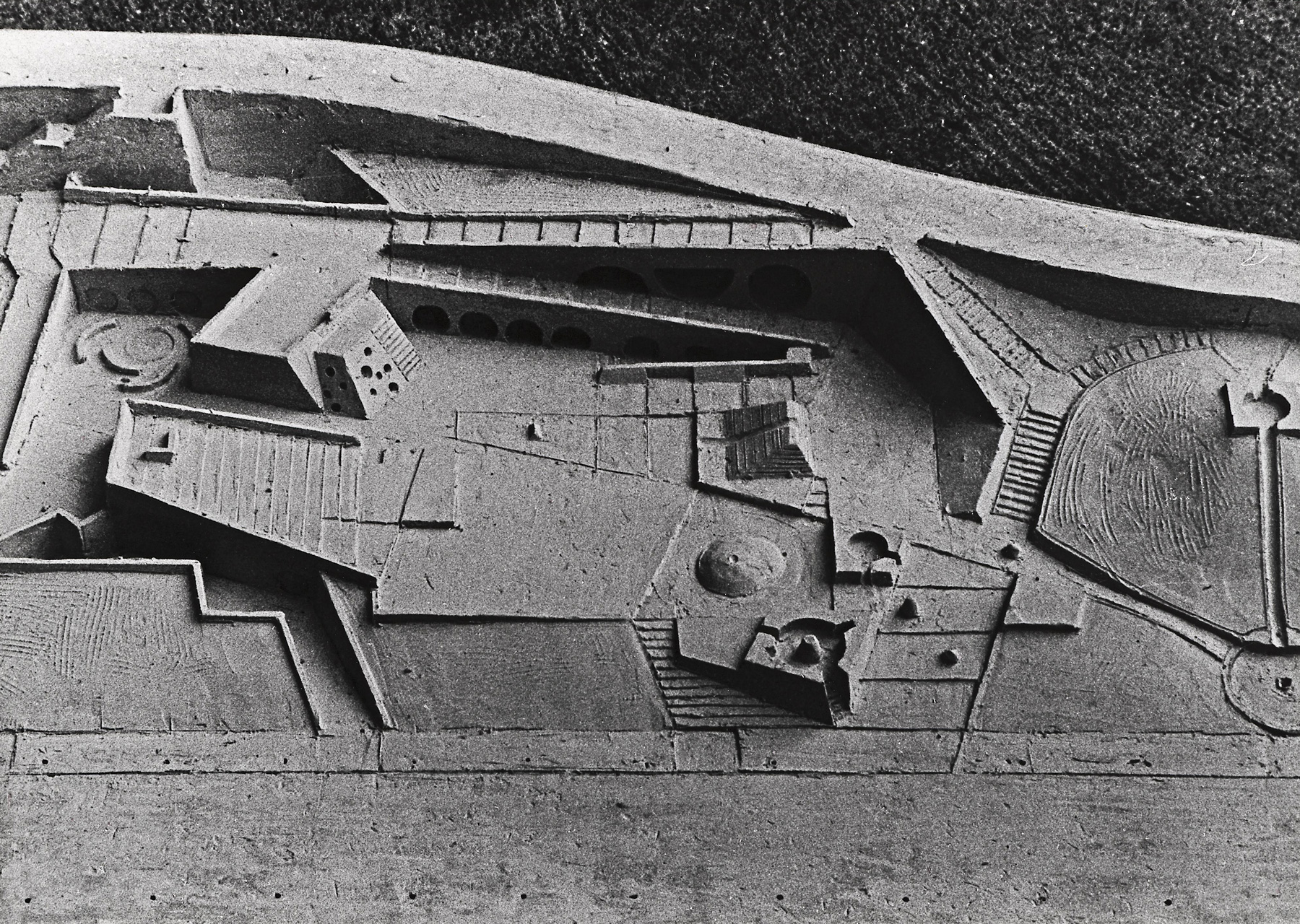

After the bitter experience in 1952 of having his design rejected for a playground at United Nations headquarters in New York, Noguchi was reticent to take on another civic commission from the same patron, Audrey Hess, in 1960. But the opportunity to make a playground—dedicated to Hess’s aunt, Adele Rosenwald Levy, at Riverside Park on New York’s Upper West Side—was one he couldn’t resist. Sensing that partnering with a well-respected architect on the project would be his insurance, Noguchi proposed Louis Kahn. A former Yale University professor then teaching at the University of Pennsylvania, Kahn was a late bloomer, teacher, and theorist whose portfolio had only begun to gain him recognition in the 1950s, when Kahn was already in his fifties. At the time, Kahn’s best-known building was his Yale University Art Gallery (for which he borrowed Buckminster Fuller’s tetrahedron for the structural canopy of its ceilings). Together they agreed on a plan for a space of play and relaxation for people of all ages, primarily composed of elemental, sculptural forms, stretching from West 101st to 105th Street. They planned for a nursery and other facilities to be concealed beneath a long ramp, terraces, and the slope of the hill itself, suggesting a recurring emphasis in Kahn’s designs on natural light penetrating interior spaces to dramatic effect. Over the course of five years and across five submitted project plans, Noguchi and Kahn met objections “one by one; to minimize the disturbance to nature; to bed the buildings into the landscape; to cope with the uncertainties of subterranean structures. To avoid the New York Central Railroad tracks below Riverside Drive; and the retaining wall supporting it; to gain more space than we took away; to double each function.”15 A combination of antagonism from community groups, budget constraints, and a new mayoral administration finally scuttled the plan. Noguchi and Kahn’s progressive ideas for play, however, found many new disciples over the next decade.




“He approaches every undertaking with the forthright application of a Buddhist trainee.”16 Arata Isozaki’s appreciation of Noguchi was based on a few encounters when he was part of Kenzo Tange’s firm in the mid-1950s, and then later when Tange invited him to serve as one of the architects for Expo ’70 in Osaka. Isozaki’s contribution for the site’s main Festival Plaza included two large-scale “Osaka Demonstration Robots,” which were installed near the ponds populated by Noguchi’s robotic fountains. It was Isozaki’s first opportunity to watch Noguchi at work “from conception to realization.”17
Noguchi later turned to Isozaki for assistance with his exhibition “Space of Akari and Stone” at the Yurakucho Art Forum (organized by the Seibu Museum) in 1985. Experience had taught Noguchi that Akari were considered subordinate to his other work in both Japan and the United States. For the Yurakucho exhibition, he tried to reframe the significance of Akari to match his own enthusiasm for them. Together, Noguchi and Isozaki approached the installation as a series of stage settings, using combinations of materials—wood, zinc alloy fencing, painted grids—to cast Akari and stone work in alternately harmonious and confrontational pairings. Some of their installations directly referenced the teahouse tradition and Japanese aristocratic villas like Katsura, which Noguchi alluded to as a nuanced way to present “many different situations in which Akari could function; for example, the limited space of poverty or the luxurious space of wealth.”18 When Noguchi was chosen to represent the United States in the 1986 Venice Biennale he again drafted Isozaki as curator and exhibition designer. Within the overall scheme, which drew on Noguchi’s play concepts and from stone sculptures created in his studios in Italy and Japan, Noguchi worked with Isozaki to come up with the feel and sequencing of the interior spaces, establishing the oppositional forces of light and dark, heft and delicacy, paper and stone.




- Isamu Noguchi, Water Garden for the Ken Domon Museum, Sakata City, Yamagata Prefecture, Japan, 1984. Photo: Michio Noguchi. ©INFGM / ARS
- Isamu Noguchi, Water Garden for the Ken Domon Museum, Sakata City, Yamagata Prefecture, Japan, 1984. Photo: Isamu Noguchi. ©INFGM / ARS
- Isamu Noguchi, Water Garden for the Ken Domon Museum, Sakata City, Yamagata Prefecture, Japan, 1984. Photo: Tisuke Ogawa. ©INFGM / ARS
- Ken Domon, Portrait of Isamu Noguchi Drawing, 1951. The Noguchi Museum Archives. ©INFGM / ARS
The son of Noguchi’s friend and collaborator, the architect Yoshiro Taniguchi, Yoshio Taniguchi, who had also spent time in Tange’s office, asked Noguchi to contribute to a design for a regional museum dedicated to their mutual friend, photographer Ken Domon in his hometown of Sakata, Japan. Taniguchi’s first design for an art gallery, the Shiseido Art Museum (1978) in Shizuoka, was well received and established his thoughtful treatment of museum and display spaces. At the site in Sakata, in an area largely defined by marshlands, Tanaguchi set his building on the shore of an artificial lake. Taniguchi and Noguchi designed an open-air garden facing the water and enclosed by galleries on either side, their walls pierced by vertical windows of subtly diminishing size. These portals and an outdoor veranda give views onto a gently sloping stone terrace that descends to just above the lake’s surface, with water skimming over its surface, an evocation of the passage of time.19 A standing basalt figure by Noguchi is positioned on the terrace, heightening the association of the garden to a stage. This lone figure surveys the lake and a glimpse of the landscape that is framed from above by a horizontal bridge joining the two peripheral walls, a visual device that functions similarly to the eave of a temple veranda.20 Noguchi and Taniguchi’s attentiveness to bringing near and distant focal points into relation through proportion and partially revealed views correlates with the photographer’s compositional strategies.




- R. Buckminster Fuller with Isamu Noguchi’s R. Buckminster Fuller, 1929. Photo: Isamu Noguchi. ©INFGM / ARS
- Isamu Noguchi, models for the Dymaxion Car, 1932. Photo: F.S. Lincoln. ©INFGM / ARS
- Fuller & Sadao geodesic dome at Expo '67 Montreal. Photo: Isamu Noguchi. ©INFGM / ARS
- Isamu Noguchi, Bucky, 1943. Wood, wire. Photo: Kevin Noble. ©INFGM / ARS
Visionary architect, engineer, and self-described “comprehensive anticipatory design scientist” Buckminster Fuller befriended Noguchi in 1929 and remained a touchstone in Noguchi’s art and philosophy from then on. Noguchi credited Fuller for his graduation from an abstract aesthetic, noting that Fuller’s “ideas were an abstraction which I could accept as being part of life and useful.”21 Although they never worked together on an architectural project, Noguchi helped with the visualization of at least one of Fuller’s projects, the Dymaxion Car, shaping the early models. Fuller spent much of the 1930s concerned with engineering economical and sustainable approaches to housing, and his observations on the innate geometric structures found in nature were applied to his architectural theories. Using the shape of the tetrahedron as his basis, Fuller arrived at the principle of “tensegrity,” using tensile units in equilibrium to form scalable structures. In the 1940s, tensegrity led to the geodesic dome, a portable, cost-efficient shelter that could be installed anywhere, and a concept that became virtually synonymous with Fuller. One of Noguchi’s portraits of his friend, Bucky (1943), was in the form of tetrahedron units around a central mast, recalling the earliest Dymaxion house plans.






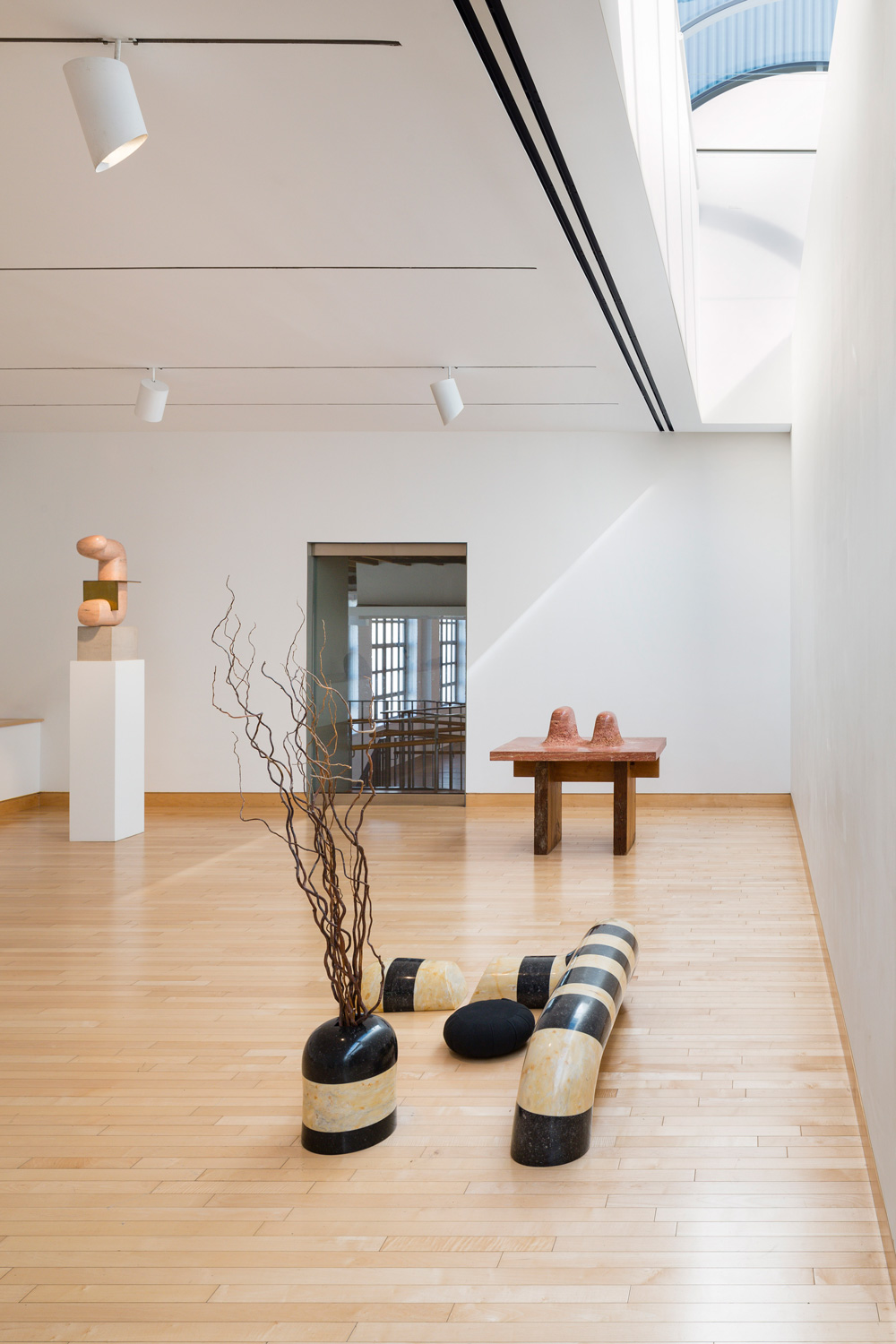
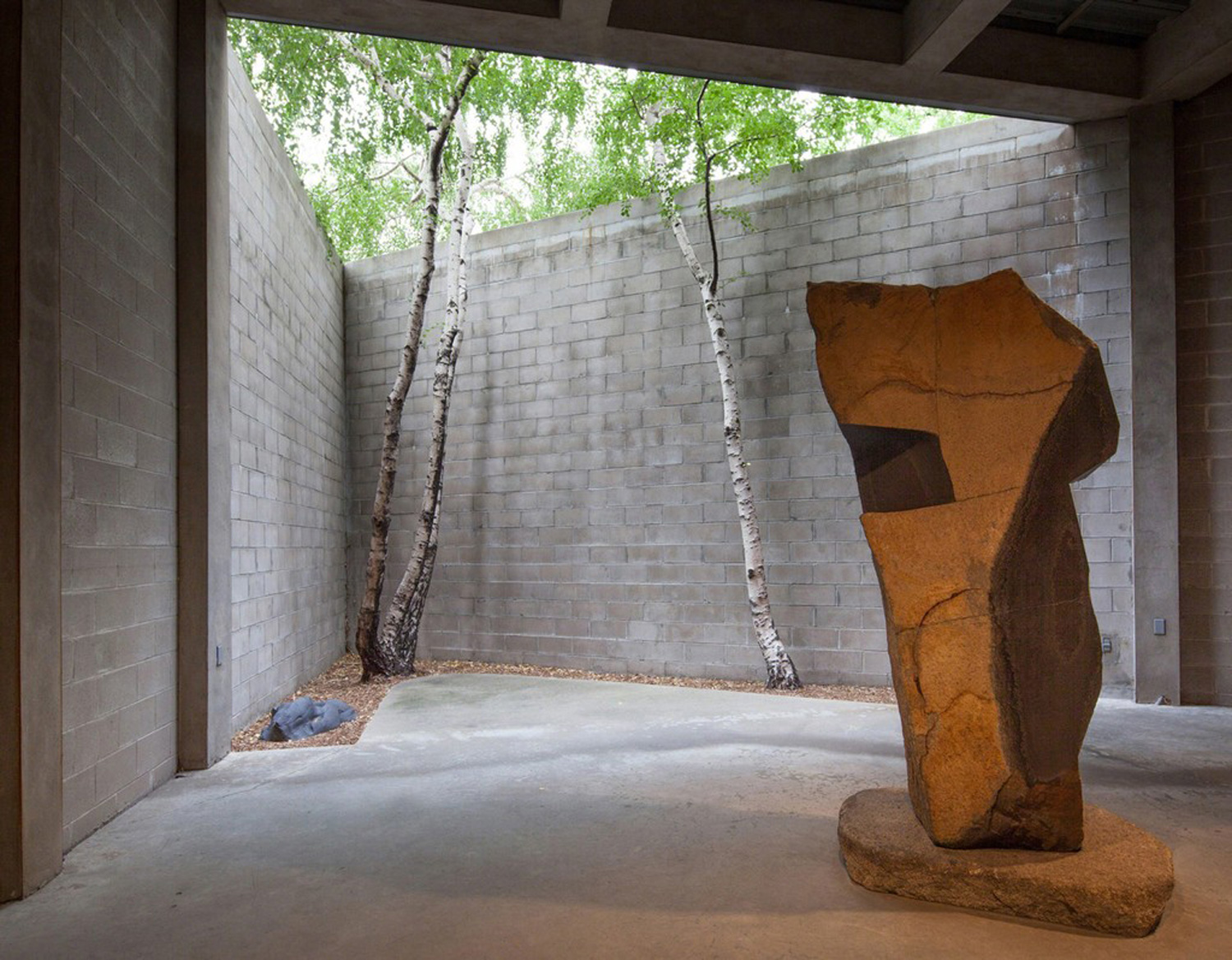
- Shoji Sadao at Isamu Noguchi’s studio in Kita Kamakura, Japan, 1957. Photo: Isamu Noguchi. ©INFGM / ARS
- R. Buckminster Fuller, Shoji Sadao, and Isamu Noguchi installing Noguchi’s Octetra in Spoleto, Italy, 1968. ©INFGM / ARS
- First page of a letter from Isamu Noguchi to Shoji Sadao, May 22, 1968. The Noguchi Museum Archives, NFP_PRO_054_014. ©INFGM / ARS
- Isamu Noguchi, Octetra, installed in Spoleto, Italy, 1968. Photo: Isamu Noguchi. ©INFGM / ARS
- Isamu Noguchi, Model for Martha Graham Dance Theater, 1976. Photo: Kevin Noble. ©INFGM / ARS
- Isamu Noguchi, Challenger Memorial, Bayfront Park, Miami, FL, 1985–87. Photo: Kozo Watabiki. ©INFGM / ARS
- Area 9 of The Noguchi Museum, New York. Photo: Nicholas Knight. ©INFGM / ARS
- Area 1 of The Noguchi Museum, New York. Photo: Elizabeth Felicella. ©INFGM / ARS
One of the many architects and engineers who helped refine Fuller’s structures was Shoji Sadao, who was a Cornell University student when he met Fuller. Sadao’s partnership with Fuller began in 1952 with another visualization exercise, a more accurate projection of global landmasses illustrated across tetrahedron panels that became known as the Dymaxion Airocean World Map. Within a decade they started a firm, Fuller & Sadao, Inc., and proceeded to translate tensegrity structures into larger scales, including a 250-foot-high dome for Expo ’67 in Montreal. Meanwhile, Sadao, who had met Noguchi in 1955 through Fuller, became an indispensable figure in Noguchi’s practice, producing architectural drawings and models and assisting in the many nuts-and-bolts aspects of engineering Noguchi’s landscape and public commissions. Sadao’s involvement was formalized with the establishment of Noguchi Fountain and Plaza, Inc. in 1971. Although Fuller and Noguchi saw each other less frequently in the 1950s and ’60s, Sadao proved to be a binding thread and a proxy for Fuller’s design principles. Among the many projects Noguchi made with Sadao were Octetra (c. 1965), a modular play structure; a model for a Martha Graham Dance Theater capped by a geodesic dome (1976–77); and a monument to commemorate the NASA astronauts killed in the 1986 explosion of the space shuttle Challenger. The Challenger Memorial (1985–87) employed a tensegrity structure to conflate the thrust and contrail of the space shuttle. Sadao also oversaw one of Noguchi’s most personal projects, the creation of The Isamu Noguchi Garden Museum (now The Noguchi Museum). Together they refurbished the raw interiors and courtyard of a former factory building across the street from Noguchi’s studio in Long Island City for use as a storage and display space. In 1981, Noguchi purchased a corner plot beside the factory and designed a cinder block extension for the planned museum, integrating a visitor’s entrance, an indoor/outdoor gallery with an interior “floating” gallery above, and an outdoor staircase leading to the reworked courtyard garden. On this rare occasion when Noguchi worked directly in the domain of architecture, it was Sadao he chose to help him translate his vision of contrasting scales, materials, and environments into spatial terms and an ideal expression of his concept of sculpture.
Matthew Kirsch is Curator and Director of Research at The Noguchi Museum.
Transcripts of archival materials are available by request to accessibility@noguchi.org.
1 Isamu Noguchi, A Sculptor’s World (New York: Harper & Row, 1968), 160.
2 Here, Noguchi states his case for expanding his commission from a sculpture to a garden space for the United States Embassy in New Delhi, India. Isamu Noguchi, letter to Edward Durell Stone, December 3, 1957. The Noguchi Museum Archives, MS_PROJ_087_011.
3 “Some people think it proves I’m an architect, but I prefer to think that the way it blends into the hill proves I’m a sculptor.” John Russell, “Castles in the Sand” [interview with Isamu Noguchi], The [London] Times, April 28, 1968. The Noguchi Museum Archives.
4 It is uncertain how Noguchi and Neutra met. However, since Neutra wrote an essay on Japanese architecture for the same 1932 issue of the Buckminster Fuller–edited Shelter magazine that featured Noguchi’s Miss Expanding Universe and Glad Day sculptures on its front and back covers, it seems probable that Fuller was their connection.
5 Arthur Millier, “Famous Sculptor Returns to This City of His Birth,” Los Angeles Times, September 1, 1935.
6 The commission essentially served as the prototype for a more streamlined coffee table, consisting of a glass sheet and two wood props, for Herman Miller (1946).
7 The park was renamed in 2018 as Gateway Arch National Park after Eero Saarinen’s winning entry, designed in 1947 and erected 1963–65.
8 Description from the second of two competition drawings, National Park Service, Gateway Arch National Park Archives.
9 Both Noguchi’s Akari (1980) and anodized aluminum sculptures, created in editions with Gemini G.E.L. (1984), were exhibited at Tengoku.
10 It is unclear if Breuer had to bear the bad news to his friend Calder about the relocation of his sculpture to another site. Marcel Breuer, letter to Isamu Noguchi, February 22, 1956, Marcel Breuer Digital Archive, Syracuse University Libraries.
11 Isamu Noguchi, Isamu Noguchi: The Sculpture of Spaces (New York: Whitney Museum of American Art, 1980), 21.
12 Gordon Bunshaft quoted in Andrea O. Dean, “Bunshaft and Noguchi: An Uneasy But Highly Productive Architect-Artist Collaboration,” A.I.A. Journal 65 (October 1976): 52.
13 “Explanation of the Sculpture Garden of The Beinecke Rare Book and Manuscript Library, Yale University, by the sculptor, Isamu Noguchi,” c. 1964. The Noguchi Museum Archives, MS_PROJ_120_001.
14 From Noguchi’s unpublished account of the failure of a proposal for Chase Manhattan, Tokyo, which Bunshaft supported, dated October 21, 1972. The Noguchi Museum Archives, MS_PROJ_153_004.
15 Noguchi, A Sculptor’s World, 178.
16 Arata Isozaki, “To Envision a Living Space,” c. 1985. The Noguchi Museum Archives, MS_EXH_229_002.
17 Ibid.
18 Isamu Noguchi, unpublished draft “Akari in Venice,” c. 1986. The Noguchi Museum Archives, MS_EXH_255_010.
19 Ana Maria Torres, Isamu Noguchi: A Study of Space (New York: The Monacelli Press, 2000), 235.
20 Taniguchi discussed this as a recurring tactic. “If you go to an old Japanese temple, you sit on the tatami mat and look out to the garden … You see the garden framed by the projecting eaves. So these eaves can be classified as a kind of architectural element that captures external space. You feel you’re sitting inside, but at the same time you are also looking at exterior space.” C. B. Liddell, “Talking with Taniguchi,” Architecture Weekly, February, 13 2008.
21 From a 1967 interview with Isamu Noguchi and Buckminster Fuller recorded in Spoleto, Italy, by filmmaker Michael Blackwood, quoted in Shoji Sadao, Buckminster Fuller and Isamu Noguchi: Best of Friends (New York and Milan: The Noguchi Museum and 5 Continents Editions, 2011), 185.
